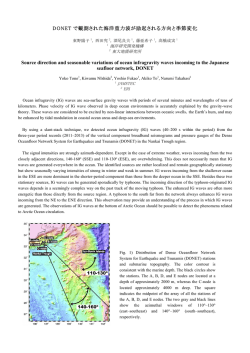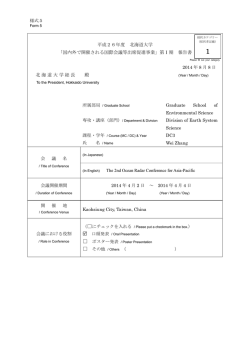
Page 1 Page 2 Page 3 Page 4 Fig, ー, Seas。naー Variati。n 。f cー
Title Author(s) Citation Issue Date URL Seasonal change of cloud distribution in the tropics Ishiwata, Chizu, Aoyama, Takayoshi Geographical Reports of Tokyo Metropolitan University(6/7): 31-37 1972 http://hdl.handle.net/10748/3415 DOI Rights Type Textversion Departmental Bulletin Paper publisher http://www.tmu.ac.jp/ 首都大学東京 機関リポジトリ Seasonal Change of Clou“Distribution in the Tropics Chizu IsHIwATA and Takayoshi AoYAMA INTRODUCTION In recent years, the climatology of the tropics makes rapid advance. However, our ㎞owledge of climate in the tropics is not satis飴ctory in comparison with temperate and polar climate. It may be consider as one of its reasons that the meteorological stations are distributed sparsely and partially because of the ocean and unciv皿ized continents. Since the launching of Tiros I in 1960, cloud observations of the whole earth become possible and the data has been accumulated even in the area that has no meteorological stations. By the launching weather satellites, the most important significance is brought to the investigation of climate in the tropics. For instance, using the data of weather satellite cloud observations, Sadler(1968)has published a pioneering monograph on the average cloudiness for each month from February,1965, to January,1967 in the tropics. For the research of climate and atmospheric circulation i郎he tropics, seasonal change in cloud distribution should be very significant. AIthough these investigations has not bebn made till now. In the present study, using the maps of cloudiness by Sadler(1968), the seasonal change of cloud distribution is first arranged. The distribution maps of the monthly rainfall and isopleth diagram−s of wind speed and direction along the meridians are made by the data from‘‘Monthly Climatic Data fbr the World”. Then these result are compared with 廿1e position of Intertropical Convergence Zone that has been presented till now and the regional characteristics about the distribution of ITCZ are exam㎞ed. CLOUD DISTRIBUTION IN THE TROPIC・S On the meridional profiles of zonally averaged cloudiness f6r February and July of 1965and of 1966, the maximum difference of cloudiness between l 965 and 1966 reaches to the value of O.6 near 5°S in July. This value is large for the Southern Hemisphere where the difference of the cloudiness among the!琴titudes, about O.6 in 1965 and O.4 in 1966,is small. By compared with the regional distributions of cloudiness in both years, the difference of the cloudiness even reaches 3 in some regions. The difference of cloudiness among the years should be interesting problem. However the authors wish to treat such a problem in another papers. The cloudy areas in the tropics may be classified to the next four groupes by its positions. Those are(1)the near−equatorial east−west oriented narrow and distinct cloudy areas over the ocean,(2)the meridionally oriented broad cloudy areas in the western portion of the ocean,(3)the meridionally oriented broad cloudy areas in the eastern portion of the ocean,(4)the seasonally apPeared cloudy areas over the continents. (1) The zonal cloudy’areas over the near・equatorial ocean These are recogniZed over the Pacific, the Atlantic and the Indian Ocean. Over the Pacific, it persists between 一31一 about 5°N and approximately 10°N throughout the year. In March and Apri1, the two zonal cloudy areas appear over the eastern Pacific. One elongates from the Atlantic at 5°N and another lies at 5°S. Over the Atlantic, it persists throughout the year between the equator and l O°N. Particularly between May and July, this cloudy area developes and stretches from South America to western Africa. Over the Indian Ocean, different state from the former areas, the zonal cloudy area appears only between November and February. In November and December, the two zonal cloudy areas are recognized between 5°N and 9°N and between 5°S and 10°S respectively. (2) The cloudy area over the western portion of廿1e ocean This cloudy area distributes over the Philipp血es, Southern China, Indo・China Peninsula, New Guinea and the Paci丘c Islands. Especially, seasonal change of this cloudy area is little in the southern part from New Guinea. (3) The cloudy area over the eastern portion of廿1e ocean This cloudy area distributes over off the west coast of North America, South America and Southern Africa. In the Southern Hemisphere, these cloudiness are cloudier in Winter than in Summer. Over the west coast of North America, it reduces its extent in March, April, October and November. (4) The cloudy area over the continent These cloudy areas are recogniZed over Africa and South America. It spread over Africa between September and April and over South America between October and ApriL But the area with the minimum cloudiness spreads over Australia throughout the year. As described above, over the North Pacific, South Pacific, North Atlantic, South Atlantic, Sahara−West Pakistan, Australia and Indian Ocean, cloudy areas which are recognized throughout a year develop among or circumference of the semipermanent anticyclones. Over South America, southern Africa and India−Indo一α血a Peninsula, the seasonal change of the cloudy area are marked. In these regions sldes are cloud・free during winter, corresponding with the development of the anticyclones. While during summer, skies are most cloudy along the low pressure zones. There may be general agreement between the distribution of cloudiness and rainfall. Using the data at l 40 stations, the quantitative relation between rainfall and cloudiness is obtained. These quantities are related each other through the following equation: N=a log P+b, where N denotes the monthly mean cloudiness and P the monthly precipitation. The constants a and b in formulae and standard deviation around the regression line for each month are calculated. The results are a:0.80∼1.41, b: 0.63∼1.02, standard deviations:0.65∼1.02. The coefficient of correlations between them are about O.7. ANNUAL CHANGES OF CLOUD DISTRIBUTION In annual changes of cloud distribution, there is remarkable difference in localities. In order to see these difference in detail, the isopleth diagrams of cloudiness along the seven 1・ngitud・・,0°,30°E,100°E,150°E,150°W,60°W,・nd 30°W・・e m・d・・E・・h di・g・am i・ explained as follows. 一32_ ’966 ノ(f 2・ぴ Fig」. Sea・・n・1・a・i・ti・n・f・1・・d di・t・ib・ti…1・ng l50°W Shaded areas are cloud cover over 5. 15。・W(cent,al Pacifi、・cean)・Z・n・lly・・i・nt・d・1・udy・・ea persi・t・b・tween 5°N .1).Cloud−free areas in 、nd 9°N th,。u帥・ut th・yea・and d…n・t・h・w mu・h・h・ng・(Fig 寵驚・t臨i潔空ec蕊濃黙潔器1ξ二翻盤ll瓢諜灘 N。,th,,n H,mi、ph・・e. Th・g・adi・nt・・f the cl・udiness b・tween the z・n・lly・1・udy a「ea nea「 ・qu・t ?B艦離謙&、1贈離騰翻盟1瓢灘9i,・N 、nd 4・N f,。m J、nu、,y t・Ap・il・nd b・tween 6°N・nd lO°N f・・m Jun・t・0・t・b…lt mig,at,、 n・・thw・・d in M・y・nd・・uthw・・d in N・v・mb・・and Decemb・・(Fig・2)・The highe「 1966 L/・ 20 ’ ゲ 1 20 Fig.2S・a・…lva・i・ti・n・f・1・ud di・t・ib・ti・n・1・ng 30°W Shaded areas are cloud cover over 5. 1、titud,、 cl。ud−f,ee a,ea, in th・・am・・t・t・a・cent・al Pacifi・Ocean・i・di・tin・t in th・ S。uth,,n H,mi、ph・・e and th・g・adi・nt・a・e mu・h・teep・・t・th…uthw・・d th・n t°the 。。,thw。,d. The cl。udy・・ea・ec・gni・・d・t・b・ut 20°N in July・nd Augu・t・・ntinu・・t・the cloudy area over off the west coast of Africa in mid−latitudes. 150・E(w・、t・・n Pacifi・Ocean−ea・t・…t・f Au・t・ali・)・Th・NW−SE・・i・nt・d・1・udy 、,ea in th・w・・t・・n S・uth Pacific and the ea・t−w・・t・・i・nt・d・1・udy・・ea nea「.the equat£「 meet in、vi、inity。f thi・1・ngitud・. The cl・udy・・ea b…dly・p・ead b・tween 10 N and lO S and the seasonal change can not be recognized・ 30・E(Af,ica)・Th・di・t・ibuti・n・f the cl・udy・・ea・h・w・th・・ea・・n・1・h・nge・The 。。,th,,n m、,9in・f the cl・udy・・ea li・・at near−・qu・t・・in Decemb・・and J・nu・・y・F・・m it、・ntinu・u・ly mig・at・・n・・thw・・d・nd・each・・at・b・ut 15°N. in A・gu・t・ February H。w,v,,, th,、。uth,・n m・・gin・di・c・ntinu・u・ly mig・at・・n・・thw・・d f・・m 20 S・・highe「 .Since the l、titud,、 in Ap・il・nd M・y・nd・each・・t・th・vi・inity・f・qu・t・・i・June and July 。n,。, tw。 m。nth、 ph、、e diff・・ence is rec・gni・・d b・tween n・・th・・n・nd・・uth・・n m・・gin・f ,June, 、1。udy、,ea, the cl・udy・・ea bec・m・・narr・w・・and・1・ng・t・f・・m w・・t Af・ica in M・y _33一 謡歯1撚e離濫1°udya「ea・ap’dlym・g・at・・w・uthw・・d・nd・each・・t・2・°S °°(贈・t Af・ica)・Th・tw・・1・udy・・ea・with it・axi・b,tween 5・N、nd 1。・N、nd between lO S can b・f・und(Fig・3)・On・i・th・N・・th・・n H・mi、ph,,e。,i,nt、 ea、t−w,、t、nd 3 1965 −IL..1.u.−1−−L2−..1−−12.−L 2 1 1 2 、ノ… ㍉ c琢2、.. 1966 3 4 5 6 7 8 9 10 〃 12 1 ol ○ Fig・3Sea・・n・l va・i・ti・n・f・1・ud di・t・ib・ti・n。1。ng O° Shaded areas are cloud cover over 5. el°ng・t・・fr・m th・At1・nti・t・Af・i・a b・tween Ap・il・nd S・pt・mb・・.1・Ap・i1、nd M、y, it 撒「糟鴬藷黙灘h藷1鵬臨縦膿繍1: cl・udiness at th・・am・tim・and bec・m・・v・gue a・the cl・udy・・ea. The cl・udy、,ea i。 th, S°uthe・唄・mi・ph・・e c・rre・p・nd・t・th・m・・idi・n・11y・・i・nt・d・nd・・ntinu・d f・・m high,, 1・titudes ln th・S・・th Atl・nti・・B・tween J・ly・nd N・v・mb・・, the c1・udiness e・peci、11y lnc「ease №≠獅п@the cl・udy・・ea bec・m・・di・tin・t b・tween July・nd N・v・mb・・. 60W(South America): Regarding its position of the northern margin of the cloudy a「ea・h・w・n・・ea・・n・1・h・nge and li・・at・b・ut 10°N th・・ugh・ut th・yea・. Th,、。。the,n 卑・・gin・h・w・v・…h・ng・・b・tween 25°S・・high・・1・tit・d・・and・q・・t・,. B,tween Jun, and Aug・・t・th…uth・・n m・・gin li・・ab・ut・qu・t・・and・・a・e・ult・f it p・・iti・n, the c1。udy、,ea 臨撒「鑑躍,響隣濫鷲ns綿鼎131臨1鷲溜二l spreads discontinuously. 100°E(1・d・−Chin・P・nin・ul・−ea・t・・n lndi・n Ocean)・The cl。udy、,ea、h。w、 the vi H1ent・ea・・n・1・h・ng・・f di・t・ibuti・n・F・・m Ap・il t・Jun・, the axi・・f the c1。udy、,ea m19「ates「apidly…thw・・d・nd・・uthw・・d in S・pt・mb・・and O・t・b・・(Fig.4). B・tween M、y and O・t・b・・, the c1・udy・・ea・each・・a・fa・a・n・・thw・・d・f 30°N. E、peci、11y, it is recognized that the broad cloudy area distributes between 5°S and the mid−latitudes in the ノ965 2(Pt ノcfi 2 Fig 4・Sea・・n・l va・i・・i・n・f・1・ud di・t・ib・・i。n。1。ng l。。・E Shaded areas are cloud cover over 5. 一34 Northern Hemisphere in August, September and October. In February and March, the cloudy area spreads from equator to the south of 30°S. However the cloudiness is not so much. J The seasonal changes of cloud distribution as described above di ffe rents in Iocalities. In summer of the Northern Hemisphere, the zonal cloudy area near the equator shows good continuity and connects with each other over the Pacific−South America−the Atlantic− Africa. Over the Pacific and the Atlantic, the position and the width of the cloudy areas does not show so much seasonal change. Over South America and Africa, however, the states of the seasonal change are strikingly different from above regions. The position of the northern margin of the cloudy area shows a very little seasonal change but the southern margin shows aconsiderable variation over these regions. The cloudiness over South America has a tendency to increase from summer to winter in the Southern Hemisphere and over Africa, a same tendency from winter to summer. Over Indo−China Peninsula and the eastern Indian Ocean, the seasonal change of the cloudy area is remarkably. In this region, it spreads from equator to the north of 30°N in summer of the Northern Hemisphere and from equator to the south of 30°S in summer of the Southern Hemisphere. THE RELATIONS BETWEEN THE DISTRIBUTION OF CLOUDINESS AND ITCZ Although the many studies of ITCZ(Inter Tropical Convergence Zone)have been done till now, results obtained are more or less different from each other. These differences mainly depend on the heterogeneous data, difference of analysed height and method. Concerning the ITCZ, the definition by WMO, the model by Flohn(1960)and by Trewartha (1961)in western Africa have been provided. According to these model, the cloudy area may be recognized near or southward of ITCZ. But the other hand, it was described in the Meeting of Meteorological Satellites by Japan Meteorological Society(1967)that the cloudy area does not always correspond to the front. According to Godshall(1968), the relations of the distribution of the ITCZ and the cloudy area seems to be different in locality. Therefore,based on the distributions of ITCZ, cloudiness, rainfall, wind speed and wind direction, the regional and seasonal characteristics of the ITCZ are studied. The geographical locations of the ITCZ in the maps shown by Yoshimura(1970)are mainly used in this report. Since his investigation based on the data in 1958,the differences of the locations of the low pressure belt near equator are examined on the monthly mean pressure maps of January and July in 1958,1965,1966 and 1967. The pressure distribution maps are taken from the‘Witterung in Ubersee’(1958,1965,1966,1967). According to the examination, the low pressure region over western Africa in July,1958,1ie about 2 degrees north of one in the other years. Over the other regions, these distinct and systematic difference is not recognized. Hence, we consider that the comparisons between the locations of the ITCZ by Yoshimura(1970)and cloudy area in this study have no contradictions. 150°W:The location of the ITCZ shows a Iarger seasonal change than cloudy area. Therefore from January to May, the axis of the cloudy area Iies about 5 degrees north of the ITCZ. But from June to December, the locations of the two agree approximately. 30°W:From May to November, the axis of the cloudy area lies about 1−2 degrees south of the ITCZ and from December to March, the relation of the location is reverse. According to the locations of the ITCZ by Yoshino(1968), the axis of the cloudy area lies 一35 内國 へ閉 (巴 h 閉 」 圏 (<) (<) 檎 O (ρq) ON Oへ 一36 about 7 degrees south of the ITCZ in June and July and about 7 degrees north in January and February. 150°E:From May to September, the ITCZ lies near the northern margin of the cloudy area and 10degrees north of the axis of the cloudy area. When we adopt the axis of the heaviest rainfall region with more than lOO mm, it lies from several to 5 degrees south of the ITCZ. From January to April, the axis of c]oudy area and the heaviest rainfall region lie about l O degrees north of the ITCZ. 30°E:The location of the ITCZ agrees with the northern margin of the cloudy area and of the wind that have south component throughout the year. Since the cloudy area and the heaviest rainfall・region coincide with each other, the axes of the two lie from several to lO degrees south of the ITCZ. Compared to the location of the ITCZ by Weickmann(1963), the southern margin of the cloudy area almost coincides with the ITCZ that lies from Indian Ocean to southern Africa. 0°:From April to September, the axis of the cloudy area lies about lO−20 degrees south of the ITCZ. The axis of the heaviest rainfall region situated near the northern margin of the cloudy area and lies about 5−10degrees south of the ITCZ. 100°E:The location of the ITCZ almost coincides with the axis of the cloudy area. In April, May, September and October, the NITCZ and the SITCZ appear and the broad cloudy area develops between them. As described above, the relations between the ITCZ and cloudiness are different in regions. These are shown in Figure 5. Over the Pacific and Atlantic, the relations between the locations of them differs with seasons. Over Africa, the ITCZ lies north of the cloudy area throughout the year. Over Indo−Cllina peninsula−the eastern Indian Ocean, the locations of the two agree approximately and the broad cloudy area spreads between the NITCZ and the SITCZ according to the seasons. Generally speaking, the distance between the ITCZ and the axis of the cloudy area is from several to about 10degrees. Especially,over western Africa, this distance is the largest, although the differences according to the years are concidered・ Tlle authors wish to express their appreciation to Prof. Dr. T. Yazawa and Dr.1. Maejilna of the Tokyo Metropolitan University for their advice and suggestions. References Cited Deutscher Wetterdienst, Seewetteramt in Hamburg(1958,1965,1966,1967):1万θWitteru ng in Ubersee. Flohn, H.,1960:ルlonsoon of the World, New Delhi,75−88. Godshall, F. A.,1968:Intertropical convergence zone and mean cloud amount in the tropical Pacific Ocean.ル1ヒ)η.レVeath. Reり.,Vol.96,172−175. Japan Meteorological Society,1967:The meeting of the meteorological satellite, Kishoκθηんアuハ10te, Vol.92,489−524.(in Japanese) Sadler, J. C.,1969:Average Cloudiness’ηthe Tropics fンom Satte〃ite Observatわn. Univ. Hawaii. Trewartha, G. T.,1961:The Earths boblem Climates. Univ. Wisconsin,95. Weickmann Jr., L,,1963:Mittlere Luftdruckverteilung im Meeresniveau wahrend del Hauptjahreszeiten im Bereiche um Africa, in dem indischen Ozean und den angrenzenden Teilen Asiens. Me teoroL Rdsch.,16Jg.,89−100. WMO,1965,1966,1967:ルlon thly Climatic Data/br the World. Yoshimura, M,,1970:Aclimatological study on the ITCZ. Tenki, Vol.17, l l 9−126.(in Japanese) Yoshino, M. M.,1968:α〃iatologア. Chijinshokan,89−94。(in JaPanese) _37一
© Copyright 2026




